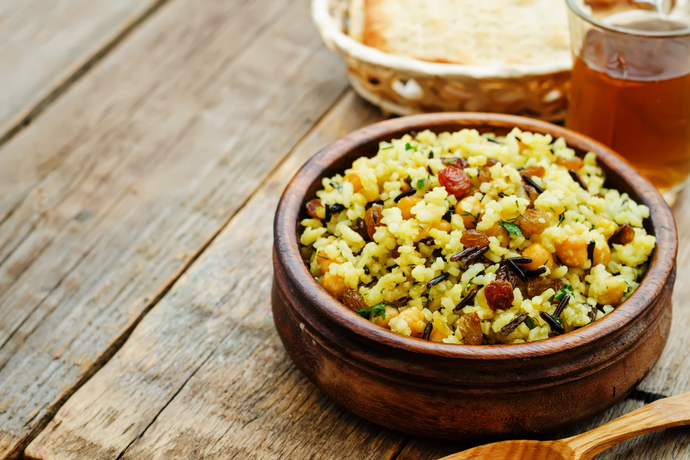
Increasing your fiber intake can come with a host of health benefits—but sometimes, your digestive health may benefit from cutting back on fiber.
Fiber is an essential nutrient to include in a healthy diet. A high fiber has a host of health benefits, from lowering cholesterol levels to controlling blood sugar. But what’s the role of fiber when it comes to digestive health?
Fiber 101
There are two types of fiber:
Soluble fiber may help improve both constipation and diarrhea by slowing digestion and improving stool consistency, and can be found in foods such as oatmeal, quinoa, squash, banana and beans.
Insoluble fiber has a stimulating effect on the GI tract and adds bulk to the stool, and can be found in foods such as whole grains, apples with skin, popcorn and leafy greens.
Eating a high-fiber diet that incorporates both soluble and insoluble fiber can help maintain bowel health and regulate bowel movements.
High-Fiber Foods
Are you looking to increase your fiber intake? It’s important to add both soluble and insoluble fiber to your diet. Start by eating a variety of these high-fiber foods:
- Apples
- Artichokes
- Barley
- Beans
- Blackberries
- Blueberries
- Broccoli
- Brown rice
- Bulgur
- Cabbage
- Carrots
- Celery
- Chickpeas
- Coconut
- Corn
- Couscous
- Cucumber
- Dates
- Farro
- Grapes
- Green beans
- Flaxseeds
- Kamut
- Lentils
- Nuts
- Oats
- Onions
- Oranges
- Pears
- Popcorn
- Prunes
- Pumpkin
- Quinoa
- Raisins
- Raspberries
- Seeds
- Squash
- Strawberries
- Tomatoes
- Whole grain breads and cereals
- Whole wheat breads and cereals
- Wild rice
- Zucchini
Pro tip: If you’re looking to add more fiber to your diet, make sure to do it slowly—adding too much, too quickly can trigger uncomfortable symptoms like gas, bloating, and cramping. Increase fiber intake gradually, over the course of a few weeks, to allow your digestive system to adjust accordingly. Choose foods that contain at least 4 grams of fiber per serving, and aim to eventually get 25 to 35 grabs of fiber each day. Be sure to drink plenty of water, to help your body process fiber.
Foods Low in Fiber
Even though fiber is a generally a part of a healthy diet, some digestive issues actually require limiting your fiber intake. A low-fiber diet should focus on the following foods:
- Cereal (varieties that contain less than 1 gram of fiber per serving)
- Cheese
- Chicken broth
- Crackers
- Cream of rice
- Eggs
- Fish
- Flavored water
- Ice cream
- Juice (varieties with no pulp)
- Meat
- Milk
- Pancakes or waffles made with white refined flour
- Poultry
- Pudding
- Tofu
- White bread (no nuts or seeds)
- White rice
- White pasta
- Yogurt
Pro tip: The ability to digest certain foods—like dairy—can vary from person to person, so work with your dietitian to come up with the best low-fiber diet for you. Be sure to read food labels, as fiber can crop up in unexpected places, like yogurt, cereal, and certain beverages. Look for foods that have a maximum of 1 gram of fiber per serving. Once your digestive health is back on track, your dietitian may recommend slowly adding more high-fiber foods back into your diet.
Texture Modified Fiber
Modifying the amount, particle size, AND texture of fiber consumed can help to alleviate symptoms that occur after meals such as abdominal pain, bloating, gas, cramping or distention.
- Canned or well-cooked, skinless, seedless vegetables
- Canned or well-cooked, skinless, seedless fruits
- Potatoes (without skin)
- Mashed potatoes
- Applesauce
- Bananas
- Vegetable based soups
- Cooked oatmeal
- Cream of wheat
- Cream of buckwheat
- Whole wheat bread (refined texture, no seeds)
- Ripe avocado
- Fruit smoothies
Pro tip: When modifying texture, try to consume smaller, more frequent meals, rather than 3 large meals per day. Focus on well cooked fruits and vegetables rather than roughage such as leafy greens. Try various textures and temperatures of foods to see which sit best with you. Fiber tolerance varies from person to person—work closely with your Registered Dietitian to figure out the right amount of fiber for you.
